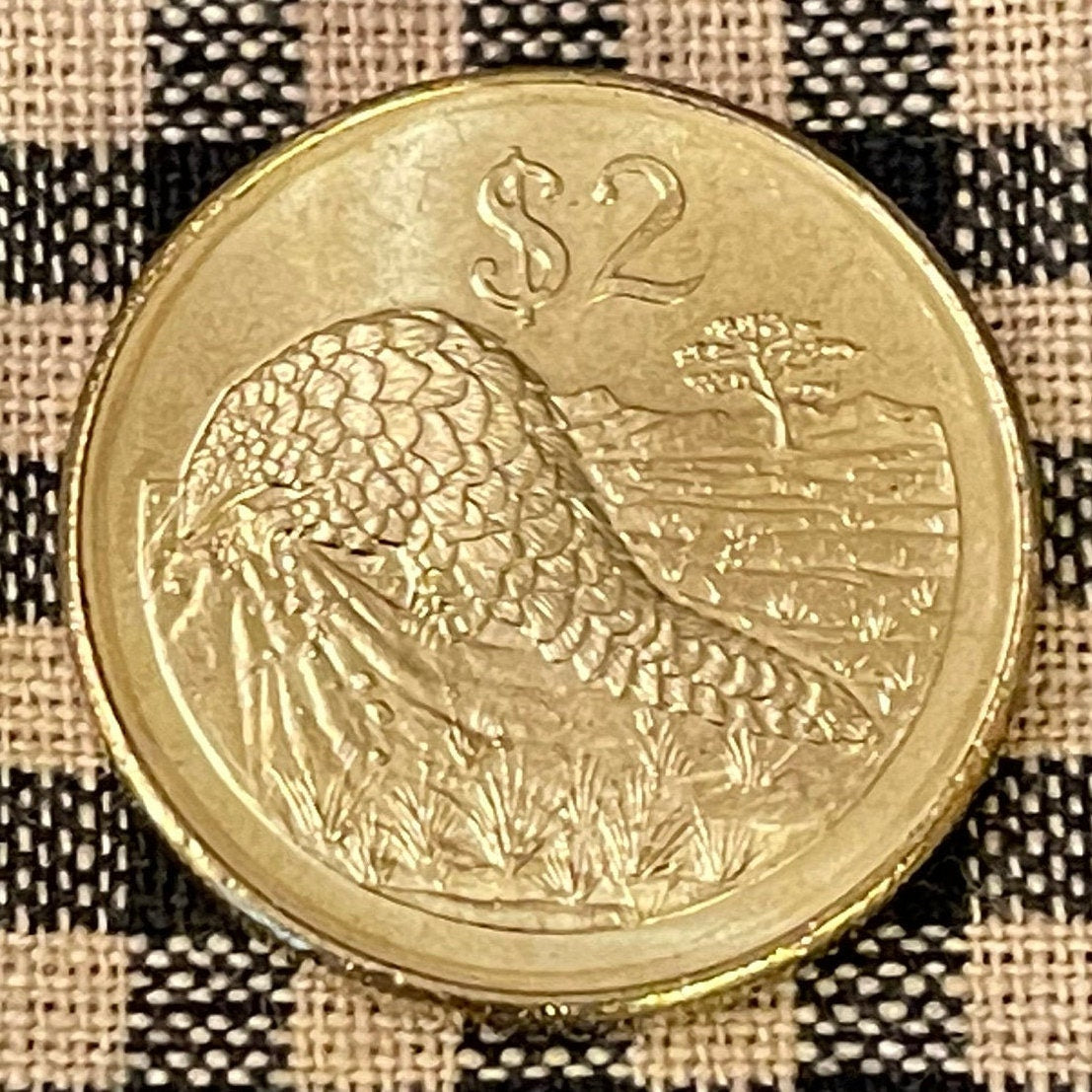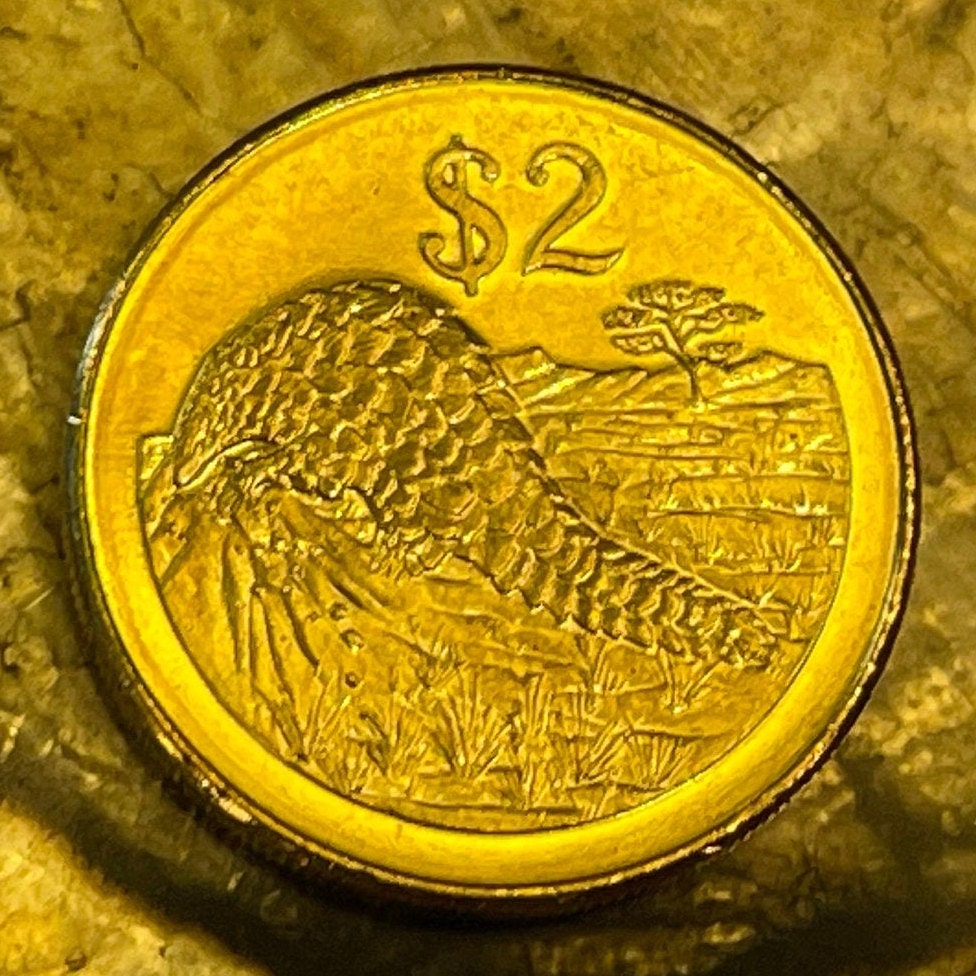elemintalshop
Pangolin 2 Dollars Zimbabwe Authentic Coin Money for Jewelry and Craft Making (Scaly Anteater) (Chinese Folk Medicine) (Lactation)
Pangolin 2 Dollars Zimbabwe Authentic Coin Money for Jewelry and Craft Making (Scaly Anteater) (Chinese Folk Medicine) (Lactation)
Couldn't load pickup availability
Pangolin 2 Dollars Zimbabwe Authentic Coin Money for Jewelry and Craft Making (Scaly Anteater) (Chinese Folk Medicine) (Lactation)
Reverse
Pangolins (Malay pang goling "one who wraps") or Manidae also known as scaly anteaters, are insectivores toothless mammal whose elongated body is largely covered with scales, which live in tropical and equatorial regions Africa and Southeast Asia.
Lettering: $2
Obverse
Representation of the protective bird, the most famous of Zimbabwe sculptures dated between XII and XIV century. Protective sculpture in the city of Great Zimbabwe, the capital of Monomotapa Empire and led Gokomere ancestors of Shona, the people of southern Africa.
Lettering: ZIMBABWE 2001
Features
Issuer Zimbabwe
Period Republic (1980-date)
Type Standard circulation coin
Years 2001-2003
Value 2 Dollars (2.00 ZWD)
Currency First Dollar (1980-2006)
Composition Brass plated steel
Weight 9.5 g
Diameter 24.5 mm
Thickness 2.9 mm
Shape Round
Technique Milled
Orientation Medal alignment ↑↑
Demonetized Yes
Number N# 16905
References KM# 12a, Schön# 61a
Wikipedia:
Pangolins, sometimes known as scaly anteaters, are mammals of the order Pholidota (/fɒlɪˈdoʊtə/, from Ancient Greek ϕολιδωτός - "clad in scales"). The one extant family, the Manidae, has three genera: Manis, Phataginus, and Smutsia. Manis comprises the four species found in Asia, while Phataginus and Smutsia include two species each, all found in sub-Saharan Africa. These species range in size from 30 to 100 cm (12 to 39 in). A number of extinct pangolin species are also known.
Pangolins have large, protective keratin scales, similar in material to fingernails and toenails, covering their skin; they are the only known mammals with this feature. They live in hollow trees or burrows, depending on the species. Pangolins are nocturnal, and their diet consists of mainly ants and termites, which they capture using their long tongues. They tend to be solitary animals, meeting only to mate and produce a litter of one to three offspring, which they raise for about two years.
Pangolins are threatened by poaching (for their meat and scales, which are used in traditional Chinese medicine [primarily as lactation stimulant for mothers]) and heavy deforestation of their natural habitats, and they are the most trafficked mammals in the world. As of January 2020, there are eight species of pangolin whose conservation status is listed in the threatened tier. Three (Manis culionensis, M. pentadactyla and M. javanica) are critically endangered, three (Phataginus tricuspis, Manis crassicaudata and Smutsia gigantea) are endangered and two (Phataginus tetradactyla and Smutsia temminckii) are vulnerable on the Red List of Threatened Species of the International Union for Conservation of Nature.
Folk medicine
Pangolin scales and flesh are used as ingredients for various traditional Chinese medicine preparations. While no scientific evidence exists for the efficacy of those practices, and they have no logical mechanism of action, their popularity still drives the black market for animal body parts, despite concerns about toxicity, transmission of diseases from animals to humans, and species extermination. The ongoing demand for parts as ingredients continues to fuel pangolin poaching, hunting and trading.
In the 21st century, the main uses of pangolin scales are quackery practices based on unproven claims the scales dissolve blood clots, promote blood circulation, or help lactating women secrete milk. The supposed health effects of pangolin meat and scales claimed by folk medicine practitioners and quacks are based on their consumption of ants, long tongues, and protective scales. The Chinese name chuan shan jia (穿山甲) "penetrating-the-mountain scales") emphasizes the idea of penetration or passing through even massive obstructions such as mountains, plus the distinctive scales which embody penetration and protection.
The official pharmacopoeia of the People's Republic of China included Chinese pangolin scales as an ingredient in TCM formulations. Pangolins were removed from the pharmacopoeia starting from the first half of 2020. Although pangolin scales have been removed from the list of raw ingredients, the scales are still listed as a key ingredient in various medicines.
The first record of pangolin scales occurs in Ben Cao Jinji Zhu ("Variorum of Shennong's Classic of Materia Medica", 500 CE), which recommends pangolin scales for protection against ant bites; burning the scales as a cure for people crying hysterically during the night. During the Tang dynasty, a recipe for expelling evil spirits with a formulation of scales, herbs, and minerals appeared in 682, and in 752 CE the idea that pangolin scales could also stimulate milk secretion in lactating women, one of the main uses today, was recommended in the Wai Tai Mi Yao ("Arcane Essentials from the Imperial Library"). In the Song dynasty, the notion of penetrating and clearing blockages was emphasized in the Taiping sheng hui fan ("Formulas from Benevolent Sages Compiled During the Era of Peace and Tranquility"), compiled by Wang Huaiyin in 992.
**********
Wikipedia:
The stone-carved Zimbabwe Bird is the national emblem of Zimbabwe, appearing on the national flags and coats of arms of both Zimbabwe and Rhodesia, as well as on banknotes and coins (first on the Rhodesian pound and then on the Rhodesian dollar). It probably represents the bateleur eagle or the African fish eagle. The bird's design is derived from a number of soapstone sculptures found in the ruins of the ancient city of Great Zimbabwe.
It is now the definitive icon of Zimbabwe, with Matenga (2001) listing over 100 organisations which now incorporate the Bird in their logo.
The original carved birds are from the ruined city of Great Zimbabwe, which was built by ancestors of the Shona, starting in the 11th century and inhabited for over 300 years. The ruins, after which modern Zimbabwe was named, cover some 730 hectares (1,800 acres) and are the largest ancient stone construction in sub-Saharan Africa. Among its notable elements are the soapstone bird sculptures, about 40 centimetres (16 inches) tall and standing on columns more than 90 cm (3 ft) tall, which were originally installed on walls and monoliths within the city. They are unique to Great Zimbabwe; nothing like them has been discovered elsewhere.
Various explanations have been advanced to explain the symbolic meaning of the birds. One suggestion is that each bird was erected in turn to represent a new king, but this would have required improbably long reigns. More probably, the Zimbabwe birds represent sacred or totemic animals of the Shona – the bateleur eagle (Shona: chapungu), which was held to be a messenger from Mwari (God) and the ancestors, or the fish eagle (hungwe) which it has been suggested was the original totem of the Shona.
Share










My friend Joanie and I just recently visited Botswana and Zimbabwe. We both love Pangolins though we never saw one. One of these is a gift for her. Well packaged in individual coin holders. Thank you. Well packed and fast shipping. I would definitely buy coins from Elemintal here on Etsy again.
Beautiful product, well packaged, quickly shipped and the perfect addition to our pangolin study in my third grade classroom. Thank you!
Shipped super quickly and arrived very well packaged
Super FUN!! Especially for a Pangolin Fan. :-)
Shop communicated that this coin was not available for drilling. I wish that this was more obvious in the description but I appreciated the communication!









